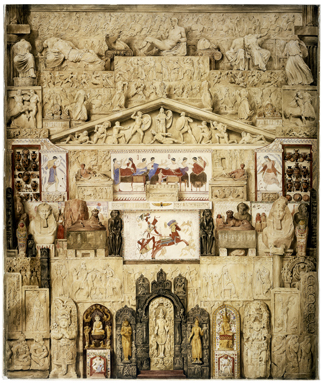7.1 The skill of ‘foreshortening’
Few would now subscribe to this ‘Story of art’ without reservation. But in this classic account, the technical ability to foreshorten limbs, to represent bodies as we actually perceive them in three-dimensional space, was seen to constitute an epochal advance that set Western art on a different level from that of the rest of the world. Whichever word you want to use – mimesis, verisimilitude, the property of being ‘realistic’ – this achievement of lifelikeness in two dimensions became regarded as the defining value of Western art.
For our purposes here, in the present study of ancient Egyptian paintings from the tomb of Nebamun, the point is not so much to celebrate this powerful account nor indeed to dispute it, but to note one of its important corollaries.
From within the conventions of our own culture, in what light are we to conceive so different a kind of art? For it is a short step from regarding verisimilitude as the goal to which art aspired, an awakening into full consciousness from a more twilight realm of sleep and dreams, to regarding the absence of verisimilitude as a kind of failure, the mark of relative cultural backwardness: the belief that other cultures didn’t paint realistically because they couldn’t (Figure 26).

The activity below explores an example of such thinking. It comes from debates in the French Academie Royale in the seventeenth century. Charles Perrault is discussing the relative merits of ancients and moderns, and at one point touches on the relationship between then-contemporary Academic art, and a type of non-Western art
Activity 1 An artistic debate
Read the following quote and then answer the questions.
Some years before Raphael and Titian, there were paintings made – they still survive – the principal beauty of which lies in the fineness of line; you can count every hair in the beard and on the head of each figure. Though Chinese art is very ancient, they have remained at this stage. They will, perhaps, soon learn to draw properly, to place their figures in noble attitudes, and attain exact expressions of all the passions. But it will be a long time before they attain a perfect understanding of chiaroscuro, the degradation of light, the secrets of perspective, and the judicious organisation of a large composition.
Charles Perrault, ‘A Digression on the Ancients and Moderns’ (1688), from Art in Theory, 1648–1815, p. 57.
- What kind of art do you think Perrault is talking about in the first sentence?
- In the next short sentence, Perrault does two things. How would you characterise them?
- What would you pick out as the key ideas in his next two sentences, ideas that define what it is that is ‘advanced’ about his own art?
Answer
- By ‘the years before Raphael and Titian’ he means ‘before the sixteenth century’, i.e. before the High Renaissance. He may be thinking of Trecento and Quattrocento art in Italy, or equally of well-known figures of the Northern Renaissance. The description of ‘fineness of line’ and ‘being able to count individual hairs’ would certainly apply to a painter like Van Eyck.
- First he equates Chinese art with the type of art we have just discussed. But more importantly, he inserts a notion of progress. The idea of ‘remaining at a certain level’ carries with it the negative sense of failing to advance to another one. Perrault regards the art of the High Renaissance, and by extension of the subsequent Academic tradition of which he himself was a leading representative, as being more developed than both earlier European art and the art of other cultures, exemplified here by Chinese art.
The first key idea is the notion of ‘drawing properly’. The second concerns the cluster of ideas in the final sentence, in particular, ‘perspective’ and ‘shading’ as the keys to organising a composition. The strong implication here is that not to employ shading and perspective is not to draw properly. It is the mark of artistic backwardness.
